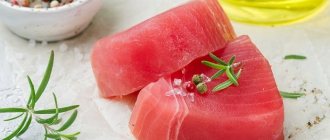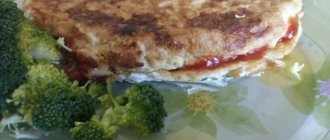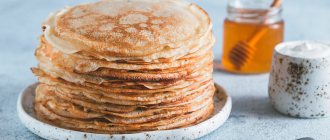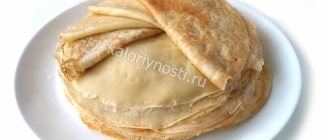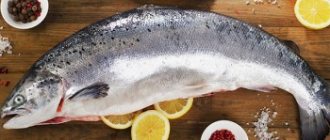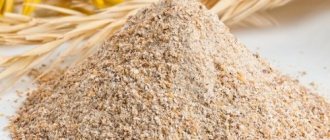Dietary properties:
How many calories are in tuna, what dietary properties it has, all this is of great interest to those who lead a healthy lifestyle and monitor their health and figure. So we will try to answer these questions in the next article.
So here it is:
In the seas of the tropics and subtropics there is a huge fish - tuna, which is one of the largest representatives of the mackerel family.
The meat of this fish has truly extraordinary taste, for which culinary experts have dubbed it “veal of the sea.”
Researchers from the Netherlands have proven through experiments that regular inclusion of this fish in the diet (at least 30 grams per day), due to its high content of the Omega-3 fat complex, halves the likelihood of developing cardiovascular diseases. It is a rich source of various microelements necessary for humans (for example, phosphorus, selenium, calcium, magnesium, iron), as well as vitamins and essential amino acids.
Eating this fish helps strengthen the immune system, helping the active synthesis of antibodies and reducing the risk of allergic reactions, it is useful for the rapid elimination of inflammatory processes, and can serve for the prevention of cancer. Tuna will also be useful for patients during treatment of cancer; it improves vision, protects us from depression and helps reduce pain from arthritis and arthrosis.
Boiled tuna recipe. Calorie, chemical composition and nutritional value.
Nutritional value and chemical composition of “Boiled tuna”.
The table shows the nutritional content (calories, proteins, fats, carbohydrates, vitamins and minerals) per 100 grams of edible portion.
| Nutrient | Quantity | Norm** | % of the norm in 100 g | % of the norm in 100 kcal | 100% normal |
| Calorie content | 169.1 kcal | 1684 kcal | 10% | 5.9% | 996 g |
| Squirrels | 29.7 g | 76 g | 39.1% | 23.1% | 256 g |
| Fats | 5.6 g | 56 g | 10% | 5.9% | 1000 g |
| Water | 67.4 g | 2273 g | 3% | 1.8% | 3372 g |
| Ash | 0.9419 g | ~ | |||
| Vitamins | |||||
| Vitamin A, RE | 17.6 mcg | 900 mcg | 2% | 1.2% | 5114 g |
| Retinol | 0.018 mg | ~ | |||
| Vitamin B1, thiamine | 0.208 mg | 1.5 mg | 13.9% | 8.2% | 721 g |
| Vitamin B2, riboflavin | 0.186 mg | 1.8 mg | 10.3% | 6.1% | 968 g |
| Vitamin B6, pyridoxine | 1.041 mg | 2 mg | 52.1% | 30.8% | 192 g |
| Vitamin B9, folates | 8.108 mcg | 400 mcg | 2% | 1.2% | 4933 g |
| Vitamin E, alpha tocopherol, TE | 0.27 mg | 15 mg | 1.8% | 1.1% | 5556 g |
| Vitamin RR, NE | 20.9459 mg | 20 mg | 104.7% | 61.9% | 95 g |
| Niacin | 10.027 mg | ~ | |||
| Macronutrients | |||||
| Potassium, K | 236.49 mg | 2500 mg | 9.5% | 5.6% | 1057 g |
| Calcium, Ca | 26.35 mg | 1000 mg | 2.6% | 1.5% | 3795 g |
| Magnesium, Mg | 16.22 mg | 400 mg | 4.1% | 2.4% | 2466 g |
| Sodium, Na | 40.54 mg | 1300 mg | 3.1% | 1.8% | 3207 g |
| Sera, S | 256.76 mg | 1000 mg | 25.7% | 15.2% | 389 g |
| Phosphorus, P | 227 mg | 800 mg | 28.4% | 16.8% | 352 g |
| Chlorine, Cl | 216.22 mg | 2300 mg | 9.4% | 5.6% | 1064 g |
| Microelements | |||||
| Iron, Fe | 1.014 mg | 18 mg | 5.6% | 3.3% | 1775 g |
| Yod, I | 67.57 mcg | 150 mcg | 45% | 26.6% | 222 g |
| Cobalt, Co | 54.054 mcg | 10 mcg | 540.5% | 319.6% | 19 g |
| Manganese, Mn | 0.1757 mg | 2 mg | 8.8% | 5.2% | 1138 g |
| Copper, Cu | 135.14 mcg | 1000 mcg | 13.5% | 8% | 740 g |
| Molybdenum, Mo | 5.405 mcg | 70 mcg | 7.7% | 4.6% | 1295 g |
| Nickel, Ni | 8.108 mcg | ~ | |||
| Chromium, Cr | 121.62 mcg | 50 mcg | 243.2% | 143.8% | 41 g |
| Zinc, Zn | 0.9459 mg | 12 mg | 7.9% | 4.7% | 1269 g |
| Sterols (sterols) | |||||
| Cholesterol | 51.35 mg | max 300 mg | |||
| Saturated fatty acids | |||||
| Saturated fatty acids | 1.8 g | max 18.7 g | |||
| 14:0 Miristinovaya | 0.3514 g | ~ | |||
| 16:0 Palmitinaya | 1.8108 g | ~ | |||
| 17:0 Margarine | 0.1757 g | ~ | |||
| 18:0 Stearic | 0.7297 g | ~ | |||
| Monounsaturated fatty acids | 0.7297 g | min 16.8 g | 4.3% | 2.5% | |
| 16:1 Palmitoleic | 0.4189 g | ~ | |||
| 18:1 Oleic (omega-9) | 0.3108 g | ~ | |||
| Polyunsaturated fatty acids | 0.5676 g | from 11.2 to 20.6 g | 5.1% | 3% | |
| 20:5 Eicosapentaenoic acid (EPA), Omega-3 | 0.2162 g | ~ | |||
| Omega-3 fatty acids | 0.6 g | from 0.9 to 3.7 g | 66.7% | 39.4% | |
| 22:5 Docosapentaenoic acid (DPA), Omega-3 | 0.0541 g | ~ | |||
| 22:6 Docosahexaenoic acid (DHA), Omega-3 | 0.2973 g | ~ |
The energy value of boiled tuna is 169.1 kcal.
Primary Source: Created in the application by the user. Read more.
** This table shows the average levels of vitamins and minerals for an adult. If you want to know the norms taking into account your gender, age and other factors, then use the “My Healthy Diet” application.
Recipe? Recipe!
How to cook this fish at home? Here is one of the recipes:
Tuna in tomato:
Products:
- Tuna -1 kg.
- Onions - 2 pieces
- Tomatoes -1 kg.
- Garlic - 2 cloves
- Wine (white) – ½ glass
- Oil, salt and pepper - to taste
- Breadcrumbs, parsley - also to taste
The fish is cleaned of bones and skin, salted and peppered. Then roll in flour and fry. Separately, lightly fry the chopped onion and garlic (in olive oil), and then add the tomatoes and simmer everything together until a thick mass is obtained. The resulting mass is wiped in a colander, salt, sugar, wine and spices are added to it - to your taste. This will give us the sauce.
Place the finished sauce on a heat-resistant tray, place pieces of fried tuna on top of the sauce, sprinkle everything on top with breadcrumbs and parsley and place the tray in the oven until browned. The fish is served on the table in the same tray.
Use in food
For the majority of the population living far from the sea, tuna is available in frozen or canned form. Fresh fish has a calorie content of 139 kcal per hundred grams. Canned food in its own juice retains all the beneficial properties of fresh fish, and its calorie content is about 110 kcal. The main use of the canned product is as a component of various salads. On sale you can find canned tuna in oil, which is cheaper than in its own juice. But their calorie content will already be 210 kcal per hundred grams, so it is necessary to consume canned tuna in oil in limited quantities so as not to harm the figure.
Frozen tuna is just as healthy as fresh tuna if the freezing and storage technology is followed. You can use it to make a fried steak or bake it in the oven. It is better to fry steak on a grill, without oil, so as not to increase the calorie content of the product.
In conclusion, we remind you that eating tuna once or twice a week will benefit the body.
- Table of proteins, fats and carbohydrates in food
- The great benefits of water for our body
- Lime water: preparation, benefits and harm
What are the benefits of tuna for weight loss?
First of all, I would really like to note that eating this fish for dietary purposes is an excellent way to lose extra pounds without losing muscle mass. The fact is that in the process of losing weight it is very important not to completely lose fat in the diet, otherwise the body will not burn its own fat on the internal organs. Another thing is that during the diet you need to consume the right fats, which will stimulate the burning of internal excess reserves.
Tuna goes best with fruit vegetables (tomatoes, cucumbers, bell peppers) and leafy vegetables (lettuce, iceberg, Chinese cabbage). An excellent addition to the salad can be onions, a stalk of celery, green peas, corn, basil sprigs and pine nuts.
One condition is that diet dishes should not be seasoned with mayonnaise, even low-calorie ones; it is best to sprinkle them with lemon juice and pour a little olive oil over them. Only with this approach to nutrition will your figure soon become slim, your skin will become elastic, and your nervous system will be in perfect order.
Calorie content of fried tuna per 100 grams
Calorie content of fried tuna per 100 grams is 150 kcal. In 100 g of fish dish:
- 20 g protein;
- 5.14 g fat;
- 6.2 g carbohydrates.
Read: Calorie content of white cabbage pancakes
To make fried tuna, we need a minimum set of products:
- 0.5 kg fresh tuna;
- 4 tablespoons olive oil;
- 1 handful of basil;
- 1 lemon.
Cooking steps:
- salt the tuna fillet and drizzle with a little olive oil;
- knead the fish so that a little salt is absorbed from the top;
- Fry the tuna over high heat until crisp. A piece of fillet 2 cm thick must be fried on each side for no longer than 1 minute;
- Mash a handful of basil, add a little olive oil and a drop of lemon juice. Mix everything thoroughly and knead again;
- Serve fish with basil juice.
More on the same topic:
Comments (1)
- LaskaS Writes, First of all, I would like to note that eating tuna for dietary purposes is a good way to get rid of excess weight without losing muscle mass. The fact is that when losing weight, it is very important not to completely exclude fats from the diet. Otherwise, our body will not break down its own fat in internal organs. But while adhering to a diet, you should consume the “right” fats, which will help burn excess internal reserves.
Who benefits from tuna?
Its benefits for the cardiovascular system have already been noted. In Japan, tuna is considered a fish that prolongs youth. After all, vitamins A and E improve the condition of skin and hair. Chromium cleanses the liver of toxins and maintains optimal glucose levels. And 280 mg of phosphorus in one hundred grams of meat improves brain activity, vision, and muscle condition.
This property makes tuna an indispensable food product for athletes. Fish protein is absorbed by 94%, covering the protein requirement. But meat benefits not only athletes, but all men without exception, increasing their male strength and activity, controlling testosterone levels.
And women value tuna for its low calorie content. One hundred grams contains about 139 kcal. Therefore, its meat can be included in the menu by anyone who wants to lose excess weight. The set of vitamins that make up fish can be called a “female beauty set.” Vitamin E is essential for the beauty and youth of the skin. Vitamin A strengthens nails and gives shine and elasticity to hair. Vitamin D - takes care of bone strength by maintaining calcium levels, which is especially important for older women.
Composition and beneficial properties
The value of canned tuna is explained by the large number of nutrients - vitamins, micro- and macroelements.
Below is a table with their content per 100 grams of product.
| Nutrient | Amount, mg | % of daily value |
| Vitamins | ||
| B4 | 29.3 | 5.9 |
| PP | 14 | 70 |
| B6 | 0.3 | 24.5 |
| E | 0.2 | 1.3 |
| B2 | 0.15 | 8.3 |
| B5 | 0.1 | 3 |
| B1 | 0.05 | 3.3 |
| B9 | 0.004 | 1 |
| B12 | 0.0026 | 106.3 |
| D | 0.0012 | 8 |
| Microelements | ||
| Iron | 1.2 | 6.7 |
| Fluorine | 1.0 | 25 |
| Zinc | 0.7 | 5.8 |
| Manganese | 0.13 | 6.5 |
| Copper | 0.1 | 10 |
| Chromium | 0.09 | 180 |
| Selenium | 0.07 | 128.4 |
| Iodine | 0.05 | 33.3 |
| Cobalt | 0.04 | 400 |
| Nickel | 0.006 | — |
| Molybdenum | 0.004 | 5.7 |
| Macronutrients | ||
| Chlorine | 1373 | 59.7 |
| Sodium | 960 | 73.8 |
| Potassium | 296 | 11.8 |
| Phosphorus | 228 | 28.5 |
| Sulfur | 225 | 22.5 |
| Calcium | 24 | 2.4 |
| Magnesium | 24 | 6 |
Benefits for immunity
Unsaturated fatty acids from canned tuna:
- participate in the structure of cells of the immune system;
- increase the activity of T-lymphocytes (regulators of the immune response) and macrophages (cells that destroy harmful bacteria).
B vitamins regulate the production of antibodies, and zinc and selenium have an antioxidant effect, thereby preventing the formation of free radicals.
Prevention of nervous system diseases
100 grams of canned tuna contain the daily requirement of cyanocobalamin (B12), which:
- protects nerve cells from damage;
- prevents the development of dementia and some mental illnesses;
- helps strengthen memory.
Folic acid (B9) is indirectly involved in the production of serotonin.
Improving the functioning of the cardiovascular system
Quite a high content of Omega-3 (170-300 mg) with niacin (PP), makes canned tuna beneficial for:
- prevention of atherosclerosis;
- strengthening the walls of blood vessels;
- blood thinning;
- normalization of pressure.
Potassium is responsible for the normal functionality of the myocardium and regulation of heart rhythm.
Strengthening bone and muscle tissue
It is difficult to overestimate the positive effect of canned tuna on the musculoskeletal system. The high content of easily digestible protein helps build muscle tissue, and when losing weight, protects it from destruction. There are all the amino acids a person needs.
The following macroelements contribute to increasing bone strength and regeneration:
- calcium;
- phosphorus;
- magnesium;
- copper.
Brief information
Tuna is a member of the mackerel family. It differs from its relatives in its enormous size and can grow up to 4.6 meters with a weight of about 684 kilograms. The weight of the largest tuna caught by an amateur fisherman was 335 kilograms.
Tuna lives in the warm tropical and subtropical waters of all oceans, but often swims into the Far Eastern regions. Unlike other fish, tuna's body temperature is several degrees higher than the temperature of the surrounding water.
Tuna is capable of swimming vast distances and reaching speeds of up to 75 kilometers per hour. High stress on the muscles during movement leads to the production of increased amounts of myoglobin, which causes the meat to turn red. Therefore, tuna is often called the “rose of the seas.”
Eating tuna for weight loss
Tuna is really necessary for weight loss. Why? The calorie content of fresh fish, canned in its own juice and steamed fish is quite low (101, 103 and 123 kilocalories per 100 g, respectively), but that’s not all. Tuna is considered a dietary product also because it contains a lot of proteins, much less fat, and in some parts there are no carbohydrates at all.
© nata_vkusidey – stock.adobe.com
Nutritionists have proven that on a diet of this fish you can get rid of 3-5 extra pounds in less than a week. All this is due to the presence of a mass of nutrients in the product. During a diet, fewer calories enter the body. This causes the metabolism to work faster, and as a result, energy is taken from fat deposits. The result is loss of excess weight. But what does it take to achieve what you want? Let's talk about everything in order.
Diet rules
Diet rules must be followed without fail. The tuna diet is an effective method for rapid weight loss. Basically it is calculated for 3 days, but there are other options. You can choose any one. By the way, we recommend that you contact a reliable specialist so that he can help you create the right menu and get out of the diet wisely.
The last question is perhaps one of the most important. After the diet ends, you need to continue to monitor your diet, eat right, excluding high-calorie foods with a lot of fat. Otherwise, all achieved results will be crossed out and excess weight will be gained again.
So, what rules are we talking about:
- Eat exclusively healthy, without being tempted by prohibited foods, the list of which will be presented below. To lose weight, you need fresh, boiled, stewed, baked or canned tuna in its own juice. Say no to fried fish.
- Don't forget about physical activity. They will help consolidate the result, remove excess fat and build muscle mass. Pay attention to sports at least once a day for at least 30 minutes. Focus on exercises aimed at general fat burning. Exercises for the cardiovascular system will be very beneficial. If you can’t exercise every day, do it every other day, increasing the duration of the workout to 1 hour. Only in combination with proper nutrition will physical exercise give results.
- There should be more than three meals (breakfast, lunch, dinner). This option is not suitable for a diet. Distribute your food so that you eat it in small portions, but more often - five to six times a day. Be sure to have snacks. The idea is to satisfy your hunger while consuming fewer calories.
- You need to drink a lot of water. The daily fluid intake is 1.5-2 liters. This will speed up the detoxification of the body: toxins and waste will be eliminated faster. Fluid retention in the body will decrease, therefore, the problem with swelling and cellulite will be solved.
Following these rules will help you achieve your goal of losing excess weight. They are all interconnected, so you need to follow all the recommendations at the same time. Only in this case will you really be able to lose weight.
Useful properties of tuna
As you can see from the table above, tuna is rich in vitamins and minerals (especially potassium, phosphorus, sulfur, cobalt and chromium), omega-3 and omega-6 fatty acids, and is also high in protein.
Moreover, in terms of the amount of protein, tuna meat is not inferior even to red meat: tuna is the leader in protein content among fish (100 grams of tuna meat contains 24 grams of protein), and chefs often call its meat “veal of the sea.”
This fish has excellent gastronomic qualities and beneficial properties, making it very popular among the population of all countries of the world.
With any type of processing, fish meat retains its beneficial qualities and taste. Tuna is boiled, stewed, baked, fried, canned and dried. On top of that, tuna is the only fish that does not harbor parasites that are dangerous to humans.
Well, as for the benefits of eating tuna meat for human health, it is advisable to eat it as often as possible. After all, tuna is capable of:
- increase metabolic rate
- significantly improve immunity
- have an antiallergic effect
- stabilize blood pressure
- improve blood circulation
- prevent blood clots and heart attack
- normalize heart rate
- improve brain function and increase mental alertness
- strengthen bones
- improve vision
- normalize blood sugar levels
- remove cholesterol from the body
- cleanse the liver of toxic substances
- restore mucous membranes
- slow down inflammatory processes
- relieve depression and improve mood
- rejuvenate the body and tighten the skin
- prevent the occurrence of carcinogenic tumors
- have a beneficial effect on hair condition
- prolong life (to confirm this property, just look at the diet of Japanese centenarians)
As you can see, tuna has a very good effect on the human body. But let us repeat once again: to obtain noticeable changes in the body, this fish must be consumed regularly.
